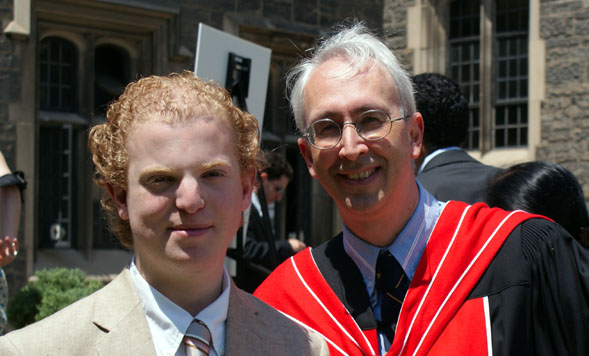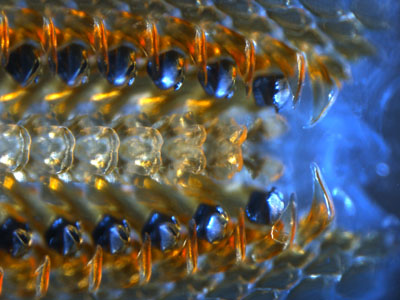Lyle Gordon (MSE 0T8) uses 3D map of atoms to analyze chiton teeth as blueprint for intelligent biomaterials design
 |
 |
Photo (left): Lyle Gordon (MSE 0T8), MSE PhD candidate at Northwestern University and Professor Steven Thorpe at Convocation 2008 (photo by Diana Mollicone, MSE 1T0)
Photo (right): Chiton teeth (Gordon, Lyle / Northwestern University)
May 25, 2011
Teeth and bone are important and complex structures in humans and other animals, but little is actually known about their chemical structure at the atomic scale. What exactly gives them their renowned toughness, hardness and strength? How do organisms control the synthesis of these advanced functional composites?
Using Atom-Probe Tomography (APT), a technique that produces an atom-by-atom, 3D reconstruction of a sample with sub-nanometre resolution, alumnus Lyle Gordon (MSE 0T8) and his PhD supervisor, Assistant Professor Derk Joester in the Department of Materials Science & Engineering at Northwestern University, have analyzed the teeth of chiton (a sea creature from the mullusks-family) to address some of the key questions surrounding organic/inorganic interfaces that are at the heart of tooth and bone structure. They are the first to produce a 3D map of the location and the identity of millions of individual atoms in the complex hybrid material that allows the chiton to literally chew rock.
“The interface between the organic and inorganic materials plays a large role in controlling properties and structure,” says Joester. “While this is in principle well known, it is intriguing to think we may have overlooked how subtle changes in the chemical makeup of nano-scale interfaces may play a role in bone formation or the diffusion of fluoride into tooth enamel. In this regard, atom-probe tomography has the potential to revolutionize our understanding.”
Joester and Gordon imaged teeth of the chiton because much is known about the bio-mineralization process. Also, chiton teeth resemble human teeth in that they have a hard and tough outer layer — equivalent to our enamel — and a softer core.
“The interface between the organic and inorganic materials plays a large role in controlling properties and structure. Subtle changes in the chemical makeup of nano-scale interfaces may play a role in bone formation or the diffusion of fluoride into tooth enamel.”
“The atom probe has been a really exciting tool to work with as we’re able to study complex biological structures on scales that were previously impossible,” says Gordon. “I want to thank NSERC, as the funding they provide has enabled a lot of my research, along with the support of Northwestern University.”
“Lyle is an outstanding materials engineer. He demonstrated exceptional talent for research during his undergraduate studies,” says Glenn Hibbard, Associate Professor & Associate Chair, Undergraduate Studies and Gordon’s undergraduate thesis supervisor. “We are all proud to see him continue to make strong progress in his career.”
Joester and Gordon are now studying the tooth enamel of a vertebrate and plan to apply APT to bone, which is also made of organic and inorganic parts, to learn more about its nano-scale structure.
The results of this research were published with the title “Nanoscale Chemical Tomography of Buried Organic–Inorganic Interfaces in the Chiton Tooth” in the journal Nature on January 13, 2011.
— With files from the Robert R. McCormick School of Engineering & Applied Science, Northwestern University